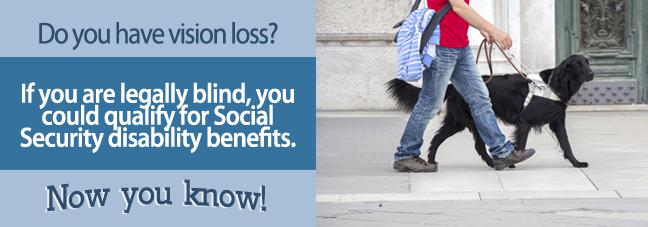Vision loss doesn’t necessarily automatically qualify for a disability benefit unless the level of blindness in both eyes is severe enough. The criteria for qualification for a disability benefit are listed in the SSA’s Blue Book.
Basically, the SSA needs to be convinced that your vision loss is severe enough to meet these criteria and additionally you are unable to earn a living for at least the next 12 months. You may be awarded a disability benefit under the SSDI scheme if you have sufficient work credits or through the SSI scheme if your assets and income are limited.
How to Automatically Qualify For a Disability Benefit
The Compassionate Allowance (CAL) program is a way that disability benefits can be fast tracked by the SSA so that someone with a severe disability can quickly obtain a benefit. In the case of vision loss, automatic qualification tends to be granted when the SSA determines that you are ‘legally blind’.
To meet this definition, your best eye must not measure any more than 20/200 visual acuity or have a visual field of less than 20 degrees. This level of vision loss must have already have been this low for at least 12 months or is expected to not achieve a higher level of visual acuity for at least the next 12 months.
The SSA may still award a disability benefit if your vision loss doesn’t quite match these criteria for a CAL, but the process of determining whether a benefit is justified may take much longer.
Does Vision Loss Automatically Qualify For a Disability Benefit?
To qualify for a disability benefit as explained above, the SSA uses the Blue Book section 2.0 Vision Loss to determine whether a benefit is justified. Just wearing glasses to correct sight is not sufficient to justify a benefit being granted.
A loss of vision in just one eye also doesn’t necessarily mean you could obtain a benefit. The SSA uses your visual acuity in your best eye as a measure of severity. The measurement standard used in 2.02 is less than 20/200 in your best eye.
If this is the case and a recent assessment by an optometrist has confirmed this low level of visual acuity then you may qualify for a compassionate allowance which can be granted quickly without the lengthy process needed for many disability benefit applications.
Even if your best eye does not match the 20/200 criterion, you may still be able to obtain a benefit if you can prove that your vision loss prevents you from doing any work you are qualified to do for at least the next 12 months. Completing a residual functional capacity (RFC) assessment may help confirm that you are unable to work.
Get Help With Your Claim
Applying for a disability benefit can be challenging and confusing. Often times, a benefit application is rejected at first and this means that an appeal needs to be made.
Denied benefit applications often happen because the medical proof of severe vision loss is not convincing or the inability to continue working for at least the next 12 months may not have been made very well. You are more likely to qualify for a compassionate allowance if you engage a disability lawyer to help you with your claim.
